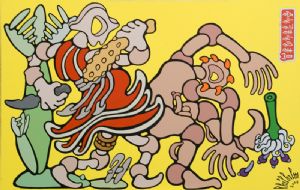| |

|

|
M85 - HOMICID AT KNOSSOS - 2008
Painting Acrylic
Size: Acrylic on canvas 125 x 190 cm or 49 x 75 inches
15330 USD
Description:
MINOAN / (Text translated by Google) / A few words about Minoan: This term was coined by Sir Arthur J. EVANS, the discoverer of a lost civilization that lived on the island of Crete in the early days? While he was looking for the origin of Greek letters, and this, from Mycenaean tablets. In 1900, he went to Crete and began excavations on the site of Knossos, which he soon bought the place, there remain 24 years by devoting his entire fortune. From the beginning of the excavations, it updates the throne room of a palace at Knossos, as well as hundreds of tablets in Linear B, then linear A. Six years later, most of the palace was unearthed. He then realizes he has just discovered a lost civilization for 2,000 years, which he dubbed "Minoan" after King Minos, a legendary king who would reign on the island ... Island more than legendary, since It is the cradle of Greek gods, and place the Labyrinth of the Minotaur retained its center! Theseus, Ariane, Daedalus and Icarus are not far away ... When the Minoan civilization, it has developed in Crete from 2700 to 1200 BC The absence of deciphering Minoan writing, the Linear A, limits our knowledge of this civilization which has been brilliant in his art! In 1400 BC, Knossos is totally destroyed either by an earthquake or by a generalized external invasion, that of the Achaeans. It seems now widely recognized that women have played a Minoan role in the life of cities. It is this supremacy that I wanted to express in this table and some others .... Of course, all elements included in this table and the series 'Minoan', are the seals of stamps from original (some more than 4500 years) and this, in a free interpretation of your artist! The monogram Philhelm lies between the legs of the Minoan.
Linear A: At the beginning of their civilization, the Cretans used a hieroglyphic form of writing, then made her move in pictographic who gave birth in Linear A, 70 syllabic signs and ideograms around 164, which are indecipherable so far by the that the language that was used is unknown. By cons, we know the letters phonetically most common, which allowed the inclusion of Philhelm in Linear A in a red cartridge: Read from bottom to top, the first letter P is written with bull horns still recognizable!
Linear B: An evolution of the previous, due to the Mycenaean invaders, which exists in two forms: logographic and syllabary, it has 87 syllabograms and hundreds of ideographs, it was deciphered by Michael Ventris in 1952. It is considered the grandfather of the present Greek.
|
|

|
|